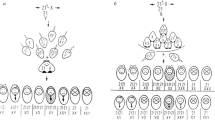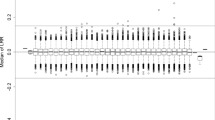Abstract
WHETHER a human embryo develops as a male or a female is determined by the presence of the Y chromosome1,2. The sex-determining function lies entirely in interval 1A, inasmuch as most XX individuals with descended testes and normal male external genitalia carry this small region of the Y chromosome3. We have localized an essential part of the sex-determining function to a portion of interval 1A, on the basis of the discovery of a female with a reciprocal Y;22 translocation and part of 1A deleted at the translocation breakpoint3. Recently, a paradox has arisen with the report4 of four partially masculinized XX individuals who carry only a portion of interval 1A—a portion that does not overlap the deletion in the X,t(Y;22) female. These recent findings imply that the sex-determining function lies in the portion of 1A present in the four XX intersexes and not in the portion deleted in the X,t(Y;22) female. To explain the X,t(Y;22) individual, it was proposed that she was female because of a chromosomal position effect4 or delayed development of the gonadal soma5. Here we report that the X,t(Y;22) female has a deletion of a second portion of interval 1A—a portion corresponding closely to that present4 in the XX intersexes. This resolves the apparent contradiction. Nonetheless, phenotype-genotype correlations suggest that two or more genetic elements in interval 1A may contribute to the sex-determining function of the Y chromosome. The X,t(Y;22) female lacks the ZFY gene but does not exhibit the complex phenotype known as Turner's syndrome, arguing against the hypothesis5 that ZFY is the Turner's syndrome gene on the Y chromosome.
This is a preview of subscription content, access via your institution
Access options
Subscribe to this journal
Receive 51 print issues and online access
$199.00 per year
only $3.90 per issue
Buy this article
- Purchase on Springer Link
- Instant access to full article PDF
Prices may be subject to local taxes which are calculated during checkout
Similar content being viewed by others
References
Ford, C. E. Miller, O. J., Polani, P. E., de Almeida, J. C. & Briggs, J. H. Lancet i, 711–713 (1959).
Jacobs, P. A. & Strong, J. A. Nature 183, 302–303 (1959).
Page, D. C. et al. Cell 51, 1091–1104 (1987).
Palmer, M. S. et al. Nature 342, 937–939 (1989).
Burgoyne, P. S. Nature 342, 860–862 (1989).
Ellis, N. A. et al. Nature 337, 81–84 (1989).
Brown, W. R. A. EMBO J. 7, 2377–2385 (1988).
Petit, C., Levilliers, J. & Weissenbach, J. EMBO J. 7, 2369–2376 (1988).
de la Chapelle, A. Hum. Genet. 58, 105–116 (1981).
Turner, H. H. Endocrinology 23, 566–574 (1938).
Ferguson-Smith, M. A. J. med. Genet. 2, 142–155 (1965).
Levilliers, J., Quack, B., Weissenbach, J. & Petit, C. Proc. natn. Acad. Sci. U.S.A. 86, 2296–2300 (1989).
Schneider-Gadicke, A., Beer-Romero, P., Brown, L. G., Nussbaum, R. & Page, D. C. Cell 57, 1247–1258 (1989).
Cooke, H. J., Brown, W. R. A. & Rappold, G. A. Nature 317, 687–692 (1985).
Rouyer, F. et al. Nature 319, 291–295 (1986).
Page, D. C. et al. Genomics 1, 243–256 (1987).
Simmler, M.-C. et al. Nature 317, 692–697 (1985).
Goodfellow, P. J., Darling, S. M., Thomas, M. S. & Goodfellow, P. N. Science 234, 740–743 (1986).
Page, D. C., Brown, L. G. & de la Chappelle, A. Nature 328, 437–440 (1987).
Fisher, E. M. C., Alitalo, T., Luoh, S.-W., de la Chapelle, A. & Page, D. C. Genomics 7, 625–628 (1990).
de la Chapelle, A. et al. in Aspects of Human Genetics (ed. San Roman, C. & McDermott, A.) 125–142 (Karger, Basel, 1984).
Litt, M. & White, R. L. Proc. natn. Acad. Sci. U.S.A. 82, 6206–6210 (1985).
Author information
Authors and Affiliations
Rights and permissions
About this article
Cite this article
Page, D., Fisher, E., McGillivray, B. et al. Additional deletion in sex-determining region of human Y chromosome resolves paradox of X,t(Y;22) female. Nature 346, 279–281 (1990). https://doi.org/10.1038/346279a0
Received:
Accepted:
Issue Date:
DOI: https://doi.org/10.1038/346279a0
This article is cited by
-
A sex-determining region on the Y chromosome controls the sex-reversal ratio in interspecific hybrids between Oryzias curvinotus females and Oryzias latipes males
Heredity (2010)
-
Mechanisms of Disease: transcription factors in sex determination—relevance to human disorders of sex development
Nature Clinical Practice Endocrinology & Metabolism (2006)
-
Reciprocal translocations: a trap for cytogenetists?
Human Genetics (2005)
-
A missing piece on the Y
Nature Genetics (1995)
-
Diverse spermatogenic defects in humans caused by Y chromosome deletions encompassing a novel RNA–binding protein gene
Nature Genetics (1995)
Comments
By submitting a comment you agree to abide by our Terms and Community Guidelines. If you find something abusive or that does not comply with our terms or guidelines please flag it as inappropriate.



